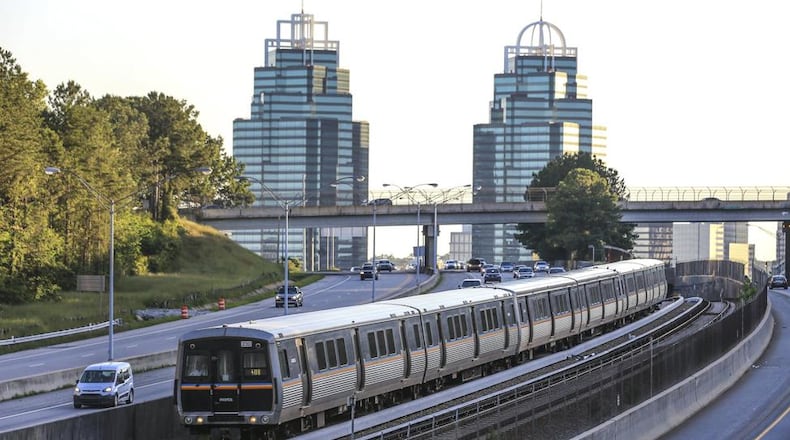Metro Atlanta transit ridership is declining. MARTA hasn’t laid a new rail line in a generation. Transit construction is dwarfed by road building.
But in coming decades, new rail lines may sprout from the existing MARTA system. An expanded network of commuter buses may ferry passengers across the region. And hundreds of thousands more people may have easy access to transit.
That's the present reality and the potential future laid out in new reports by the Atlanta-Region Transit Link Authority, or the ATL Board for short. On Friday, the agency will take a big step toward creating that future when it considers a $27.4 billion transit plan for 13 metro counties.
It’s a plan designed to pry metro residents away from their cars — one that will require public support for more transit spending to become a reality. ATL Board member Howard Mosby likened it to investing in your children’s college fund.
“It would be nice to use the money to buy a new Corvette,” Mosby said. “What I need to do is make sure my child gets a college education. It’s an investment.”
Just a few years ago, the prospect of a major regional transit expansion seemed laughable. MARTA finished its last rail line in 2000. Suburban voters had long spurned public transportation. Republicans in the General Assembly were hostile to transit — and MARTA in particular.
But the region's traffic mess has gotten worse — a recent report by the Texas A&M Transportation Institute showed metro Atlanta commuters wasted an average of 77 hours a year stuck in traffic in 2017, up from 52 hours a few years earlier. And the construction of several corporate headquarters along MARTA lines has convinced many lawmakers of the economic development benefits of transit.
Last year they approved legislation allowing 13 metro counties to approve sales taxes for mass transit, with their voters' consent. Lawmakers also approved $100 million for bus rapid transit facilities along Ga. 400 in Fulton County. And they created the ATL Board to oversee transit planning and funding in the region.
In recent weeks, the board has produced two documents that show the current reality and possible future of transit across the region.
The first is an annual report packed with statistics describing metro Atlanta's hodgepodge of transit services. It paints a picture of a region that has been reluctant to embrace public transportation.
Just 4% of the region's commuters use public transportation, while 82% drive alone to work. Transit ridership declined about 13% to 125 million trips from 2015 to 2019, due to cheap gas, the rise of ride-hailing services and other factors. Last year the region spent just $276.3 million on transit capital projects — a fraction of what the state spent on a single road project, the $834 million Northwest Corridor Express Lanes.
Still, Chris Tomlinson, the ATL Board’s executive director, sees a glass half full. He said the existing transit system makes life better even for people who don’t use it. He said traffic would be even worse if tens of thousands of transit customers were forced to drive.
Expanding transit ridership is the goal of the ATL Board's second recent document — a 20-year plan featuring 192 projects.
The plan includes major rail projects such as the Clifton Corridor in Atlanta and commuter rail to Clayton County, as well as bus rapid transit lines along the region's highways. And it includes more frequent service and other improvements to existing transit lines and stations.
The ATL Board says implementing the plan would put 420,000 additional jobs within half a mile of rail or bus rapid transit stations. And it would put an additional 394,000 low-income and minority households or households without a car within walking distance of those lines.
How much of that plan ever gets built will depend on voters' appetite for transit expansion. Recent referendums have yielded mixed results — voters in Atlanta and Clayton County approved transit expansions, while Gwinnett County voters rejected one earlier this year.
What’s more, the plan won’t end long-standing debates about whether and what kind of transit makes sense for metro Atlanta. For example, some observers say bus rapid transit makes more sense than rail, which usually costs far more and takes longer to build.
“The cost benefit of rail relative to vehicles on tires is not good,” said Steve Dickerson, a retired Georgia Tech engineering professor and an ATL Board member.
Still, advocates say that plan has already produced something that didn’t seem possible until recently — a regionwide discussion about transit expansion.
“It’s about time,” Mosby said, “that we did this as a region.”
Metro Atlanta’s transit plan by the numbers
Cost: $27.4 billion
New transit lines: 973 miles
Enhancements to existing lines: 1,126 miles
Area: 13 counties: Cherokee, Clayton, Cobb, Coweta, DeKalb, Douglas, Fayette, Forsyth, Fulton, Gwinnett, Henry, Paulding, Rockdale.
Timeline: 20 years
More information: www.atltransit.ga.gov/
About the Author
Keep Reading
The Latest
Featured




